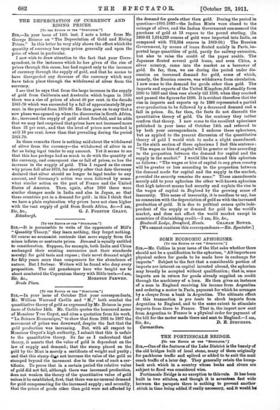[TO THE EDITOR OF TEE " STECTATOE."1
SIR,—In your issue of October 21st your correspondents, Mr. William Warrand Carlile and "M.," both combat the quantitative theory of gold as expressed by Mr. Briscoe in your issue of October 14th. Mr. Carlile quotes the honoured name of Monsieur Yves Guyot, and cites a quotation from his work, "La Science Economique," to show that from 1891 to 1897 the movement of prices was downward, despite the fact that the gold production was increasing. But, with all respect to Monsieur Guyot's high authority, I submit that this is unfair to the quantitative theory. So far as I understand that theory, it asserts that the value of gold is dependent on the law of supply and demand; that the stamp placed on the gold by the Mint is merely a certificate of weight and purity ; and that this stamp dqiis not increase the value of the gold so stamped beyond the increment due to the cost of such a cer- tificate. To prove that in a certain period the relative value of gold did not fall, although there was increased production, does not weaken the theory of the quantitative value of gold unless it be established, first, that there was no unusual demand for gold compensating for the increased supply ; and secondly, that the prices of goods other than gold were not affected by the demand for goods other than gold. During the period in question-1891-1897—the Indian Mints were closed to the coinage of silver, and the Indian Government commenced the purchase of gold at 15 rupees to the pound sterling. (In 1890-91 1,014,229 ounces of gold were imported into India, as compared with '773,384 ounces in 1889-90.) The Russian Government, by means of loans floated mainly in Paris, im- ported large quantities of gold, partly for railway extension, but also to raise the credit of the paper rouble. The Japanese floated several gold loans, and even China, a silver country, came into the market as a borrower of gold. So far, then, we see during the period under dis- cussion an increased demand for gold, some of which, namely, the Russian reserve, was withdrawn from circulation. I now come to the demand for goods other than gold. The imports and exports of the United Kingdom fell steadily from 1890 to 1893 and then rose slowly till 1898, when they reached and passed the figures for 1890. It is evident therefore that the rise in imports and exports up to 1890 represented a partial over-production to be followed by a decreased demand and a fall in prices. So, far then, the facts do not discredit the quantitative theory of gold. On the contrary they rather confirm that theory. I now come to the excellent aphorisms published in your issue of October 14th and referred to by both your correspondents. I endorse these aphorisms, but as applied to the present discussion of the quantitative theory of gold I would wish to make a slight amendment. In the sixth section of these aphorisms I find this sentence : " The wages or hire of capital will be greater or less according to the proportion between the demand for capital and the supply in the market." I would like to amend this aphorism as follows : "The wages or hire of capital in any given country will be greater or less according to the proportion between the demand made for capital and the supply in the market, provided the security remains the same." These amendments merely add to your aphorism the other well-known aphorism that high interest means bad security and explain the rise in the wages of capital in England by the growing sense of insecurity. This sense of insecurity, it is needless to say, has no connexion with the depreciation of gold as with the increased production of gold. It is due to political causes quite inde- pendent of the supply or demand for gold in the world's market, and does not affect the world market except in countries of diminishing credit.—I am, Sir, &c.,
Studwell Lodge, Droxford, Hants. GRAHAM BOWER. [We cannot continue this correspondence.—En. Spectator.1










































 Previous page
Previous page